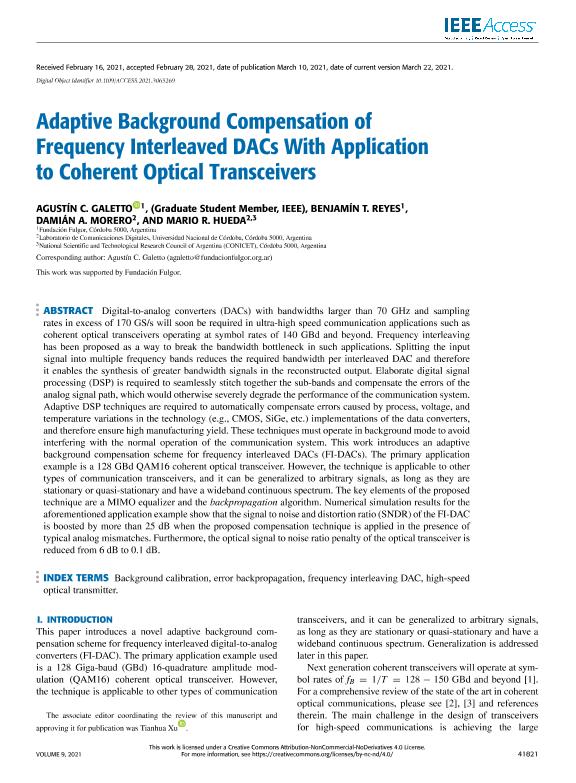Artículo
Adaptive Background Compensation of Frequency Interleaved DACs with Application to Coherent Optical Transceivers
Fecha de publicación:
03/2021
Editorial:
Institute of Electrical and Electronics Engineers
Revista:
IEEE Access
ISSN:
2169-3536
Idioma:
Inglés
Tipo de recurso:
Artículo publicado
Clasificación temática:
Resumen
Digital-to-analog converters (DACs) with bandwidths larger than 70 GHz and sampling rates in excess of 170 GS/s will soon be required in ultra-high speed communication applications such as coherent optical transceivers operating at symbol rates of 140 GBd and beyond. Frequency interleaving has been proposed as a way to break the bandwidth bottleneck in such applications. Splitting the input signal into multiple frequency bands reduces the required bandwidth per interleaved DAC and therefore it enables the synthesis of greater bandwidth signals in the reconstructed output. Elaborate digital signal processing (DSP) is required to seamlessly stitch together the sub-bands and compensate the errors of the analog signal path, which would otherwise severely degrade the performance of the communication system. Adaptive DSP techniques are required to automatically compensate errors caused by process, voltage, and temperature variations in the technology (e.g., CMOS, SiGe, etc.) implementations of the data converters, and therefore ensure high manufacturing yield. These techniques must operate in background mode to avoid interfering with the normal operation of the communication system. This work introduces an adaptive background compensation scheme for frequency interleaved DACs (FI-DACs). The primary application example is a 128 GBd QAM16 coherent optical transceiver. However, the technique is applicable to other types of communication transceivers, and it can be generalized to arbitrary signals, as long as they are stationary or quasi-stationary and have a wideband continuous spectrum. The key elements of the proposed technique are a MIMO equalizer and the backpropagation algorithm. Numerical simulation results for the aforementioned application example show that the signal to noise and distortion ratio (SNDR) of the FI-DAC is boosted by more than 25 dB when the proposed compensation technique is applied in the presence of typical analog mismatches. Furthermore, the optical signal to noise ratio penalty of the optical transceiver is reduced from 6 dB to 0.1 dB.
Archivos asociados
Licencia
Identificadores
Colecciones
Articulos(IDIT)
Articulos de INSTITUTO DE ESTUDIOS AVANZADOS EN INGENIERIA Y TECNOLOGIA
Articulos de INSTITUTO DE ESTUDIOS AVANZADOS EN INGENIERIA Y TECNOLOGIA
Citación
Galetto, Agustín C.; Reyes, Benjamín Tomás; Morero, Damián Alfonso; Hueda, Mario Rafael; Adaptive Background Compensation of Frequency Interleaved DACs with Application to Coherent Optical Transceivers; Institute of Electrical and Electronics Engineers; IEEE Access; 9; 3-2021; 41821-41832
Compartir
Altmétricas




